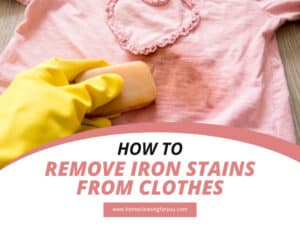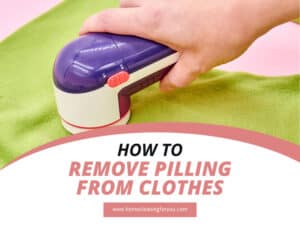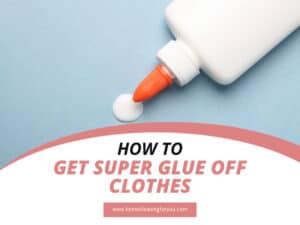How to Remove Stubborn Fabric Softener Stains from Clothes
How to get fabric softener stains out of clothes? One day you open the dryer and see some mystery blue stains on your garment; it could be because of the fabric softener you put in while washing your clothes. So, how can you deal with it?
You are in the right place. I will show you the quickest method to deal with the stains and also provide some helpful advice to avoid having them in the first place. Let’s go!

Can Fabric Softener Leaves Stains On Clothes?
Fabric softener, as its name, helps soften the fabric and makes your skin feel comfortable while touching the garments. The fabric softener reduces the static between fibers, which helps sustain your garment(1).
Additionally, one of the best conveniences that fabric softener brings to your clothes is making your clothes wrinkle-free. Yup, this product has many benefits, but it could leave annoying stains on your clothes if you are not careful.
Usually, when doing laundry, people tend to pour an abundant amount of liquid fabric softener unconsciously. As a consequence, the excess softener will stay on your clothes and cause stains. The stains will get more challenging after the clothes are dried under high heat.
Fabric softener stain is categorized as chemical-based stains. Solving these stains is not that complicated as long as you follow my instructions below.

It’s Time To Remove The Fabric Softener Stains
Now that you know why your clothes got those blue stains, the next step is to prepare some equipment and ingredients for the pre-stain treatment process.
Identify The Stains
Before you take your washed clothes to the dryer, check your garments carefully to see if there are any discolorations. Don’t dry these stained clothes because the heat will set the stains and make the process more challenging.
Suppose you don’t use any softener in the first place. It could be a stain from the bearing oil of an old washing machine. Read the washing machine manual to find an oil sprayer in your device; if there is some leaked oil, call a mechanic.
In case your washing machine is brand new, the problem might come from the water and the detergent you use. The solution here is to change the detergent to an enzyme-based one.
So, if fabric softener is the cause of the stains on your clothes, let’s get rid of them in the next section.

Let’s Handle The Softener Stain
Hey, there are various ways to deal with the discoloration from the fabric softener. Choose the option that is available in your house to take action as fast as possible.
Option 1: Bar Soap – For Light Stains
This small object could help you big time with the stained area. The bar soap is great for washing out the stains. If your clothes are not heavily stained, this should be the best choice.

Preparation
- A bar soap (dish soap, body wash, or shampoo will work as well)
- A soft-bristled brush (optional)
Instructions
Step 1: Wet the stained area with warm water. Remember to check the care label and use the highest temperature recommended in this step.
Step 2: Rub a bar of soap on the garment for a couple of minutes and create the foam on the stained surface. If you use other recommended substitutes, use your finger and rub on the discolorations.
Note: Only use the white soap with no color added. Soap that contains added smell, lotions, or other added ingredients is not recommended in cleaning the stains. For body wash, shampoo, and dish soap, a small amount of these ingredients is enough.
Step 3: Use the soft-bristled brush and gently rub on the stain. Don’t use too much force unless the fibers are damaged.
Step 4: Rinse the garment and launder your clothes as usual.
Step 5: Check your clothes. If the stain is still there, repeat step 3 and step 4. After a few times, the stain will entirely fade away.
Step 6: Dry your clothes.
Option 2: White Vinegar
Let me tell you a little secret, white vinegar alone can help handle the stained fabric. Here is how you should use it for fabric softener stains.

Preparation
- A cup of distilled white vinegar
Instructions
Step 1: Place your stained clothes into the washing machine.
Step 2: Pour a cup of white vinegar into the water. Dilute the liquid with water before you pour it into your clothes. You can put the vinegar into the machine first, then start the device and throw your garments in. The vinegar will mix with the water before touching your clothes.
Note: Don’t use undistilled vinegar for colored fabric because it can discolor your garments.
Step 3: After the machine runs the complete cycle, dry your clothes.
Option 3: White Vinegar And Bar Soap
White vinegar always has outstanding performance when it comes to cleaning stains on the fabric. And the cleaning effect is enhanced when combined with bar soap. I think you will love the result.

Preparation
- A toothbrush
- Warm water
- A bar of soap (or a small amount of laundry detergent)
Instructions
Step 1: Clean the excess softener with a toothbrush.
Step 2: Use warm water to rinse the fabric. I suggest using the temperature suggested on the care tag not to ruin the fibers.
Step 3: Rub bar soap on the stained area to loosen the stain. If you don’t have soap, a little amount of laundry detergent available in your house will work.
Step 4: Rinse the foam with warm water.
Step 5: Launder the garment. This time, use white vinegar as detergent. The vinegar works like a charm.
Step 6: Dry your clothes.
Option 4: Liquid Detergent – For Stubborn Stains
If the stain is stubborn, try using concentrated liquid detergent. This cleaning agent is strong to get rid of the softener stain.

Preparation
- A bottle of liquid detergent
- Warm water
Instructions
Step 1: Rinse the stained surface with warm water. Make sure you check the care label to use the suitable temperature for your garment.
Step 2: Rub the liquid detergent directly on the stain. Massage the stained area gently to allow the liquid to penetrate deeper into the fabric. Then, leave the detergent there for a couple of minutes.
Step 3: Now, wash your clothes with warm water and detergent.
Step 4: Check the stain; if it is still there, repeat step 2 and step 3 until the stain is gone or becomes inconspicuous.
Step 5: Dry your garment.
Option 5: Dish Soap
Another alternative for stubborn softener stains, dishwashing liquid, is excellent to blow away the annoying discolorations.
Preparation
- A bottle of dish soap
- A toothbrush
- White vinegar as a detergent
- A big plastic bowl
- Warm water
Instructions
Step 1: Brush the affected area with the toothbrush
Step 2: Moisten the stain with warm water.
Step 3: Massage the dish soap liquid on the affected zones.
Step 4: Prepare a bowl of warm water and a little amount of dish soap. Submerge the garment into the substance for roughly two hours.
Step 5: After that, rinse your clothes with warm water to wash the foam and the stain away.
Step 6: Launder your garment and use vinegar as a detergent.
Step 7: Put your garment into the dryer.

How About The Softener Stains On Dry Clothes?
What if you figure out the stain after drying your clothes? This type of stain is a little harder to deal with, but with proper care, the stain will go away. Oxygen-based bleach will be your savior; let’s see how you should do it.
Preparation
- A bottle of oxygen-based bleach
- Warm water
- A big plastic bowl
Instructions
Before you start, although oxygen-based bleach is considered color-safe bleach, you better check the care label or make a spot test in the unnoticeable area to make sure the bleach doesn’t harm your favorite clothes.
Step 1: Mix a solution of oxygen-based bleach and warm water. You should follow the instructions on the bleach bottle to make the right mixture.
Step 2: Wet the garment with warm water. You need to moisten the stain first to solve it easier.
Step 3: Soak the stained garment into the mixture for approximately 4 hours. You can even submerge the clothes overnight to loosen the stain entirely.
Step 4: Wash the garment alone without any detergent or softener. Set the washing machine at the highest temperature suggested in your garment care tag.
Step 5: Observe the stained area one more time before putting your clothes in the dryer.

Useful Tips On Preventing Fabric Softener Stains
Instead of cleaning the stains, you could prevent them from the beginning. I have some amazing tips to avoid getting these annoying stains right here.
Shake The Softener Bottle
Over time, the ingredients inside the bottle of liquid softener will separate. This might create a concentrated liquid that is hard to dissolve and leaves stains on your clothes. So shake the bottle well before using it to soften your garments.
Dilute The Softener With Water
To help the softener disperse quickly, you should dilute it with water. Use the same amount of water and mix with the liquid softener. If your washing machine has a softener dispenser, use the suggested ratio to dilute the liquid.
Never pour the softener directly on the fabric because the fabric will absorb the liquid and form unpleasant stains.
Clean The Dispenser
After quite a long time of use, clumps will form inside the dispenser and stain your clothes. Open your washing machine and flush the dispenser with white vinegar or hot water.
Then wash the machine with the rinse cycle mode, don’t add any garments, allow the water to clean all the softener residue away.
Watch this video: A detailed guide on how to clean the fabric softener dispenser in the washing machine.
Avoid Overloading The Washing Machine
Stuffing too many clothes in the machine will prevent the softener from traveling around your clothes. Stuck fabric softener will then cause annoying stains on your garment. So, separate the laundry in a suitable amount for each wash.
Try Alternative Fabric Softener
Besides liquid, other types of softener could be a great replacement if you want to reduce the chance of having stains. Dryer sheets, wool dryer balls, or aluminum dryer balls can play the role of liquid fabric softener perfectly.
However, this doesn’t mean that these choices don’t stain your fabric. If you try dryer sheets, put the sheet on top of your garments, one to two sheets will be enough for daily laundry. Remember to dilute these softeners with water to avoid discolorations on your clothes.
How Do You Soften Fabric Naturally?
Sick of the stains of common softeners? I have some ingredients that can act as a fantastic softener for your clothes. Try them!
Soap Nuts
Soap nut is a two-in-one natural laundry detergent. This ingredient is well-known as a detergent for your clothes. Plus, saponin inside these soap nuts can soften the fabric and leave your clothes a gorgeous natural smell.
Put a few nuts inside a cotton bag and throw it in your washing machine. Each bag can be used up to 10 times, fascinating, right?

Baking Soda
This multitasker cleaning agent is also helpful as a softener. Every time you want to use it, just use ½ cup in your laundry and rinse. Baking soda is friendly for sensitive skin and also available in almost every grocery store around you.
Citric Acid
Although citric acid doesn’t have a beautiful smell like commercial softeners, it doesn’t damage the fibers and irritates the skin. Citric acid helps balance the alkaline pH level of your laundry, which gives a comfortable feeling to your skin.
Mix one liter of water and five or six tablespoons of citric acid if you use the powder one. For the liquid citric acid, use 50 ml for every wash. Don’t use this acid for colored clothes because it might bleach the fabric.
White Vinegar
Yes, my friend. White vinegar can act as a natural softener. You can pour one cup of vinegar into the dispenser or dilute it with water and apply it to your clothes. This ingredient is safe, friendly, and so convenient for you.
You don’t have to worry about the smell because it will vanish after laundering. The good part is there will be no stains on your clothes. So, try white vinegar at the next laundry time.
Wind Drying
If you use your clothes with white vinegar, hang them and let them air dry. The UV ray in the sun will disinfect the fabric and eliminate lingering stains. Wind drying is, of course, free and environmentally friendly.
Hanging the clothes on a nice windy day will also reduce the wrinkles on your garments. Wind drying after washing your clothes with vinegar will take the softness to a higher level.
Dryer Balls
Dryer balls will help take out all the lumps and detergent residue on your washing machine. Apply some essential oils on the dryer ball to add a better smell to your clothes.
A set of 6 dryer balls will be good for around 3 – 4 years(2). Also, you can make yourself wool dryer balls to save money, and they are also great at softening your clothes.
Using dryer balls to soften your clothes is simple and budget-friendly. Watch this video to know:
FAQs
Still have some wonders about fabric softener stains? Let’s clarify them by answering the frequently asked questions.
Cleaning Softener Stains Is Like A Piece Of Cake
Just go through some simple steps, your clothes will look like new. Removing fabric softener stains out of clothes is not that difficult. Plus, all the ingredients are easy to find, so don’t be panicked if you have some discolorations on your clothes.
You can also use my suggestions to soften your clothes naturally. I hope that the provided information is helpful for you. If you love it, hit the like button and share this post with your friends.

Reference
1. En.wikipedia.org. 2021. Fabric softener – Wikipedia.
2. Cityofpaloalto.org. 2021. Wool Dryer Balls: A Reusable Fabric Softener.







Kevin Jones
Founder & Chief Home Organization Strategist
Expertise
Home Organization & Decluttering, Efficient Cleaning Methods & Stain Removal, Sustainable Cleaning Practices, DIY Home Maintenance & Repairs, Space Optimization & Storage Solutions, Budget-Friendly Home Care Strategies
Education
University of Texas at Austin
Kevin Jones is the Founder and Chief Home Organization Strategist at HomeCleaningForYou.com.
He earned a Bachelor of Science in Interior Design from the University of Texas at Austin, focusing on space planning and sustainable design. Specializing in home organization, decluttering, and budget-friendly home care, he helps homeowners create functional and stylish spaces.
Kevin has been featured in lifestyle publications and has collaborated with eco-friendly brands on home organization solutions. He shares his expertise through DIY guides, workshops, and online tutorials. Passionate about minimalism, he enjoys testing new organization methods and exploring sustainable living ideas.